![Tribal Members Aim to Stop Lithium Nevada Corporation From Digging Up Cultural Sites in Thacker Pass [Dispatches from Thacker Pass]](https://dgrnewsservice.org/wp-content/uploads/sites/18/2021/06/SageGrouse-980x667-1.jpg)
by DGR News Service | Jun 15, 2021 | Biodiversity & Habitat Destruction, Colonialism & Conquest, Lobbying, Mining & Drilling
Fort McDermitt, Nevada – As soon as July 29, 2021, Lithium Nevada Corporation (LNC) plans to begin removing cultural sites, artifacts, and possibly human remains belonging to the ancestors of the Paiute and Western Shoshone peoples for the proposed Thacker Pass open pit lithium mine.
According to a motion for preliminary injunction filed by four environmental organizations in the case Western Watersheds Project v. United States Department of the Interior, LNC intends to begin “mechanical trenching” operations at seven undisclosed sites within the project area, each up to “40 meters” long and “a few meters deep.” The corporation also plans to dig up to 5 feet deep at 20 other undisclosed sites, all pursuant to a new historical and cultural resources plan that has never been subject to meaningful, government-to-government consultation with the affected Tribes or to National Environmental Policy Act analysis.
Daranda Hinkey, Fort McDermitt Paiute and Shoshone tribal member and secretary of a group formed by Fort McDermitt tribal members to stop the mine, Atsa Koodakuh wyh Nuwu (People of Red Mountain) states: “From an indigenous perspective, removing burial sites or anything of that sort is bad medicine. Our tribe believes we risk sickness if we remove or take those things. We simply do not want any burial sites in Thacker Pass or anywhere in the surrounding area to be taken. The ones who passed on were prayed for and therefore should stay in their place, no matter what. We need to respect these places. The people at Lithium Nevada wouldn’t go and dig up their family gravesite because they found lithium there, so why are they trying to do that to ours?”
LNC’s Thacker Pass open pit lithium mine would harm the Fort McDermitt Paiute and Shoshone Tribe, their traditional land, and traditional foods like choke cherry, yapa, ground hog, and mule deer. It would also harm water, air, and wildlife including sage grouse, Lahontan cutthroat trout, pronghorn antelope, and sacred golden eagles.
Thacker Pass is named Peehee mu’huh in Paiute. Peehee mu’huh means “rotten moon” in English and was named so because Paiute ancestors were massacred there while the hunters were away. When the hunters returned, they found their loved ones murdered, unburied, rotting, and with their entrails spread across the sage brush in a part of the Pass shaped like a moon. According to the Paiute, building a lithium mine over this massacre site at Peehee mu’huh would be like building a lithium mine over Pearl Harbor or Arlington National Cemetery.
Land and water protectors have occupied the Protect Thacker Pass camp in the geographical boundaries of LNC’s open pit lithium mine since January 15. Will Falk, attorney and Protect Thacker Pass organizer, says: “Our allies, the People of Red Mountain, do not want to see their ancestors disturbed and their sacred land destroyed. We plan on stopping Lithium Nevada and BLM from digging these cultural sites up.”
On Tuesday, June 15th at 11am PST / 2pm EST, we will be phone banking to Secretary of Interior Deb Haaland (Laguna Pueblo) to ask that she rescind (cancel) the Record of Decision for Thacker Pass, delay the project for consultation, and meet with Atsa Koodakuh wyh Nuwu (People of Red Mountain) to discuss the issues here.
During this phone bank, we will be live streaming a press conference featuring Fort McDermitt tribal members and other concerned people. Please join us by filling out the information on this form and join us to #ProtectPeeheeMu’huh / #ProtectThackerPass!
SIGN UP HERE: https://forms.gle/z4Y2w2dKaw7WMHwE6
Event hosted by People of Red Mountain, One Source Network, Moms Clean Air Force, and Protect Thacker Pass. Please share widely!
For more on the Protect Thacker Pass campaign
#ProtectThackerPass #NativeLivesMatter #NativeLandsMatter

by DGR News Service | Jun 14, 2021 | Biodiversity & Habitat Destruction, Direct Action, Education, Movement Building & Support, Obstruction & Occupation
This article originally appeared in The Conversation.
By David Tindall, Professor of Sociology, University of British Columbia
The RCMP has recently been arresting protesters who had set up blockades to prevent the logging of old-growth forests on Vancouver Island. Environmentalists say the Fairy Creek watershed, near Port Renfrew, is the last old-growth area left on southern Vancouver Island, outside of protected areas.
The contested forested areas lie close to the internationally known West Coast Trail, and within the unceded traditional territory of several First Nations, including Pacheedaht and Ditidaht.
Some of the trees are more than 1,000 years old and are part of rare ecosystems that some independent estimates suggest make up less than one per cent of the remaining forest in B.C. Close to 25 per cent of the world’s remaining temperate rainforest is in B.C., mainly along the coasts.
The demonstrators established the first blockade in August 2020 along the logging roads into the Fairy Creek watershed, where Teal-Jones has a “tree farm licence” to harvest timber and manage forest resources. Now dozens of people, including some First Nations youth, have been arrested for violating a B.C. Supreme Court order that restricts protesters from blockading the logging roads.
This dispute resembles the protests over Clayoquot Sound (also on the west coast of Vancouver Island). Dubbed the “War in the Woods,” more than 850 people were arrested in 1993 for blockading logging roads. That protest, sparked by a decision to allow logging in the area, was the largest act of civil disobedience in Canadian history and a seminal event in the history of the environmental movement.
As a researcher of social movement and environmental issues, I have been surveying the general public and environmental activists about their attitudes and behaviours for about three decades. I am particularly interested in environmental conflicts and the factors (such as social networks) that explain why people get involved incollective actions to protect the environment or to protest against such actions (pro-industry protesters).
This research can shed light on current and future conflicts. People who support the goals and values of a movement can be drawn into it, what social movement scholars call “the mobilization potential.” However, involvement is often contingent upon other factors, such as social ties to other participants.
‘War in the Woods’ redux?
The connection between Fairy Creek and Clayoquot Sound was highlighted when Tzeporah Berman — a high-profile environmentalist and a leader of the Clayoquot protests — was arrested at a road leading into the Fairy Creek watershed in May.
Berman, who is also the director of the environmental organization Stand.earth, co-ordinated the blockade in Clayoquot Sound 27 years ago. She was arrested then too, although the long list of charges was eventually dismissed on constitutional grounds. No large-scale industrial logging occurred in Clayoquot in the aftermath of the protests.
More recently, anti-logging protests focused on the old-growth forest in the Great Bear Rainforest. Environmentalists, the forestry sector, First Nations and the B.C. government eventually worked together to establish a 2016 agreement to protect the Great Bear Rainforest.
Since then, various environmental groups have continued to campaign to protect old-growth forests. But these efforts have often been overshadowed by protests against oil and gas pipelines and overarching activism about climate change.
Understanding beliefs about old-growth forests
An old-growth forest is one that has not been disturbed by large-scale human activities, such as industrial logging. In B.C., these forests have been growing since the last ice age, about 10,000 years.
They include gigantic trees such as red and yellow cedars, Sikta spruce, hemlock and Douglas firs, which are sometimes as tall as a football field or soccer pitch is long. One thousand-year-old trees may be the most iconic features of coastal old-growth forests, but the forests also promote biodiversity by providing habitat to numerous wildlife species, many of which do not thrive outside of old-growth forests.
Logging has contributed to the dramatic decline of B.C.‘s old-growth forests. One independent study suggested that the majority of B.C.’s productive old-growth forests have been logged, and there are plans to log the majority of what remains.
In a 2007 survey, my group found that 75 per cent of the general public completely or mostly agreed that “clearcut logging should not be allowed in old-growth forests.” So did 93 per cent of environmentalists.
We also asked about the statement: “Some forested areas should be set aside in order to protect endangered and threatened species (e.g., the spotted owl, the spirit bear).” Here, 94.2 per cent of the general public and 98 per cent of environmentalists completely or mostly agreed.
In 2005, >I members and supporters of the Friends of Clayoquot Sound, one of the main organizations involved in the protests. That study asked people about various types of civil disobedience, and found that 90 per cent of environmentalists believed that blockading logging roads greatly or somewhat helped the cause, and 84 per cent believed that occupying trees greatly or somewhat helped the cause.
It is difficult to assess the outcomes of social movements, but civil disobedience has been successful in the past. Media attention, changing public opinion and disruption can put pressure on governments to change course.
Growing protests
Protesters have been blocking access to logging roads and positioning themselves high in trees to disrupt harvesting operations in the Fairy Creek area, drawing the attention of the media and the public and putting pressure on government. The RCMP responded slowly at first, but recently began to enforce the court injunction and have restricted access to the protest sites.
While the protest has been going on since late last summer, its activities have recently heated up. Environmentalists want the government to adopt the recommendations from a new advisory report on old-growth forests. It seems likely that the protest will grow.
A large number of people see civil disobedience as being effective and are willing to do it. Once the B.C. government eases COVID-related restrictions, more people will likely become involved in protests. Pleasant weather and flexible summer schedules may encourage others to join. Satellite protests regarding the threat to old-growth forests will also continue in urban centres.
The RCMP says it has arrested more than 100 people already, and 75 seniors from the Victoria area have joined the protest at Fairy Creek. This may just be the beginning of another “War in the Woods.”
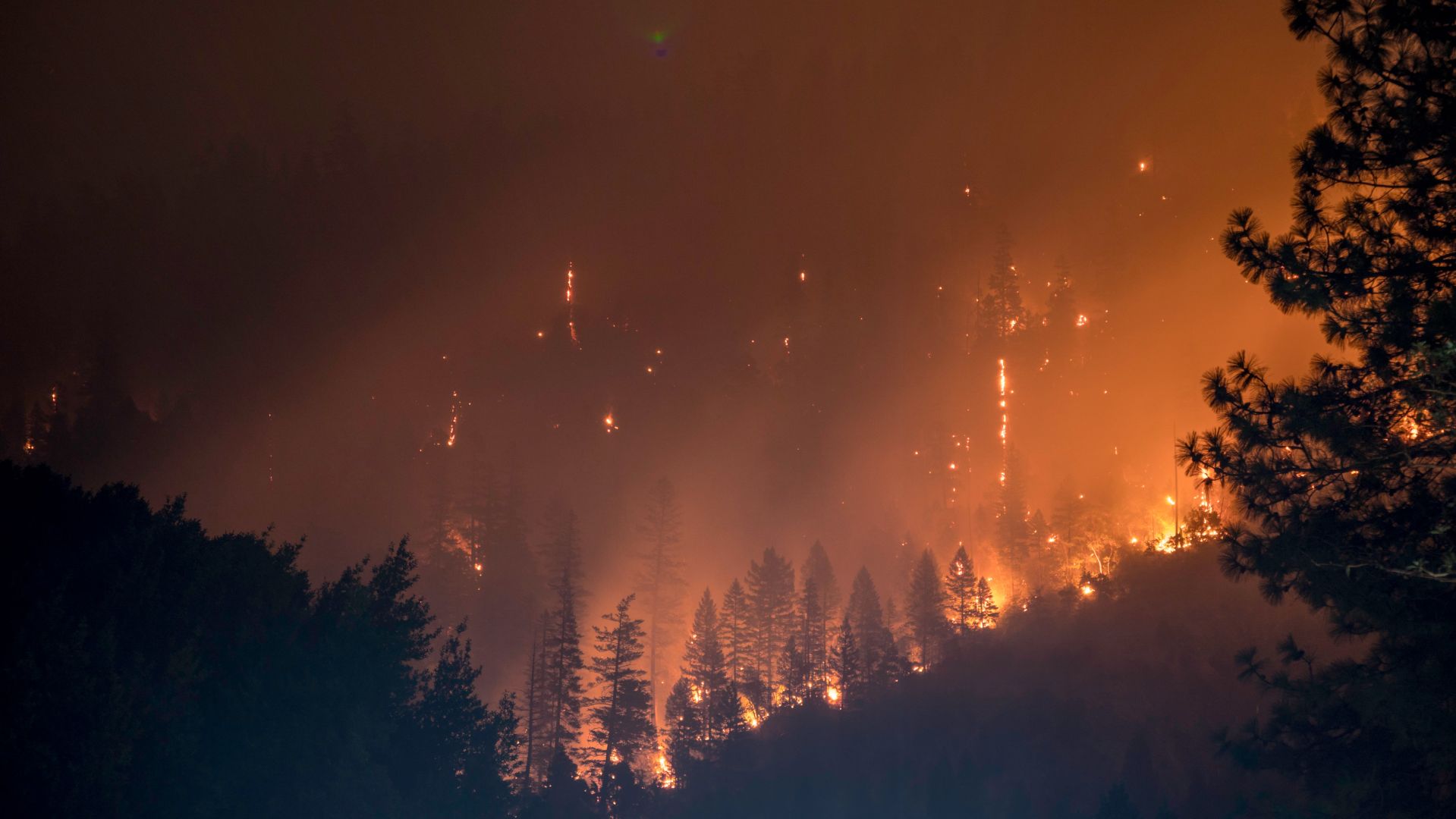
by DGR News Service | Jun 12, 2021 | Biodiversity & Habitat Destruction, Climate Change
This article originally appeared on Counterpunch.
BY GEORGE WUERTHNER
In a recent May 29 Bend Bulletin article, Senator Merkley asserted he “wants to boost spending on forest management by $1 billion annually through work, such as thinning and prescribed burning, to reduce the prospects of catastrophic wildfires.”
An unexamined assumption is that thinning/logging work significantly reduces the pejoratively named “catastrophic” fires.
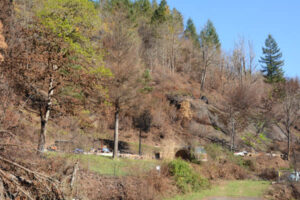
The Holiday Farm Fire burned the western slopes of the Cascades driven by extreme fire weather conditions, including high winds, charred acres of clearcuts, and other “fuel reductions.” Photo George Wuerthner.
Despite assertions from the Forest Service and others who will gain financially from inflated budgets to log our forests, one needs to ask if “fuel reductions” work to halt wildfires when burning under extreme fire weather conditions. That qualifier is important. All large blazes, like those that charred the western Cascades last Labor Day, burn swiftly through logged sites and other “fuel reductions.”
All such blazes occur under drought conditions, high temps, low humidity, and high winds. Thinning/logging and prescribed fires will not significantly preclude large blazes burning under extreme fire weather conditions.
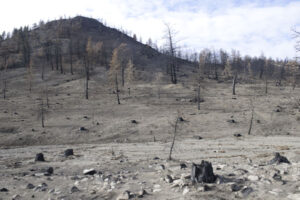
This fire in the Scratchgravel Hills by Helena, Montana, driven by 50 mph, burned through this forest that had been thinned just six months prior to the blaze. Photo George Wuerthner.
I have traveled extensively around the West to view the aftermath of the largest fires, and every single one occurred during extreme fire weather conditions. Nothing, including thinning, logging, and prescribed burns, works to contain such fires when you have these conditions. I know of no exceptions.
Such blazes are only contained when the weather conditions change. Logging does not change the weather.
When it “appears” that fuel reductions worked under extreme conditions, you need to examine the actual burn circumstances during the blaze—the intensity of fire changes hour by hour.
Proponents of forest thinning, including Merkley, suggest previous thinning projects saved Sisters, Oregon from the 2017 Milli Fire that burned within 2-3 miles of town. Yet if you read the Fire Incident Report carefully, such conclusions are questionable.
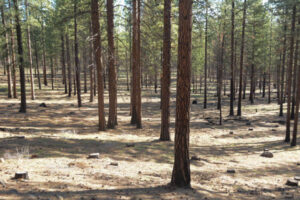
Thinned ponderosa pine stand near Sisters, Oregon, has resulted in a mono-culture of nearly even-aged forest that degrades the forest ecosystem and doesn’t stop fires burning under extreme fire weather. Thinning kills trees to preclude natural processes from killing trees. Photo George Wuerthner.
The Milli Fire burned through two previous burns (Pole Creek and Black Crater), presumably “fuel reductions.” It also burned through some thinned stands before thinning “saved” Sisters.
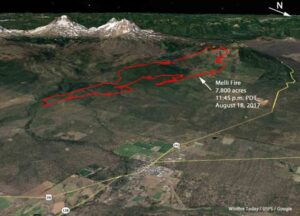
The red outline shows the wind-driven effect of the Milli Fire. A change in wind direction “saved” Sisters—photo USFS.
What happened is that the wind that had been moving the fire towards Sisters shifted, pushing the fire west and north into lava fields in the Three Sisters Wilderness.
Did thinning save Sisters? Maybe? However, a more nuanced analysis might conclude that a change in weather patterns is what “saved” Sisters.
Worse for our communities is that the Forest Service is “selling” a myth. Thinning/logging has been shown to increase fire spread. Thinning opens the forest to more wind penetration and more soil drying—both factors are conducive to fire spread during extreme fire weather.
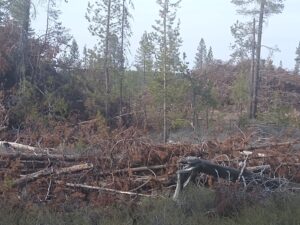
Logging/thinning on the Deschutes NF leaves many fine fuels on the ground, often exacerbating fire spread. Photo George Wuerthner.
What burns in wildfires are the fine fuels: grass, shrubs, pine needles, small trees, and so forth. Large trees that thinning removes typically do not burn. That is why we have “snags” after a severe fire.
While thinning and prescribed burning treatments might lower fire intensity briefly immediately after the treatment, the chances that a fire will encounter a treatment is extremely rare.
Ironically, fuel reduction often increases the percentage of fine fuels on a site, ensuring that a blaze can readily spread if driven by high winds.
Ignored in the race to log our forests is that high severity fires are essential to healthy forest ecosystems. The biodiversity they produce often exceeds what is found in “green forests.”
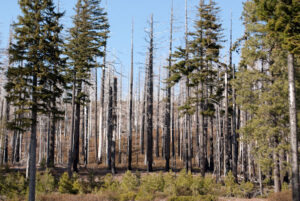
Snags are critical to a healthy forest ecosystem. This is a sign of forest “health.” Photo George Wuerthner.
So the “story” the FS sells that thinning is “improving” forest health is another inaccurate statement. Dead trees resulting from fires, bark beetles, and other natural factors are critical to healthy forest ecosystems.
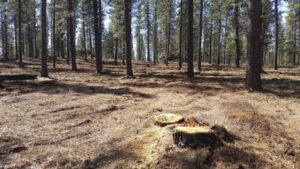
A sanitized forest stand (restoration) on the Deschutes NF, Oregon. Note the lack of small trees, lack of species diversity, lack of snags, down wood, and even shrubs. Photo George Wuerthner.
Thinning/logging is not benign. There are many impacts to the forest ecosystem from “restoration,” “fuel reductions,” and other euphemisms used to justify commercial logging. These include the spread of weeds, sedimentation in streams from logging roads, displacement of sensitive wildlife, loss of biomass, and loss of carbon storage.
Ultimately, we must deal with the GHG emissions that drive climate change, increasing drought, variable weather, and the conditions that favor large blazes.
In the meantime, increasing thinning and prescribed burning, except in the immediate area around communities, does little to protect homes. A much better way to spend scarce funds is to assist communities and homeowners in reducing the flammability of homes, burying power lines, and precluding new home construction in fire-prone areas.
George Wuerthner has published 36 books including Wildfire: A Century of Failed Forest Policy. He serves on the board of the Western Watersheds Project.
![The Rush For White Gold [Dispatches from Thacker Pass]](https://dgrnewsservice.org/wp-content/uploads/sites/18/2021/06/APrice-ThackerPasssky-1080x675-1.jpg)
by DGR News Service | Jun 11, 2021 | Biodiversity & Habitat Destruction, Climate Change, Direct Action, Indigenous Autonomy, Listening to the Land, Mining & Drilling, Movement Building & Support, Obstruction & Occupation, Toxification
by Austin Price, for Earth Island Journal
SIXTEEN MILLION YEARS AGO, a volcano erupted over the Yellowstone hotspot near the present-day border of Oregon and Nevada. The blast expelled 1,000 cubic kilometers of rhyolite lava as the land collapsed into a 30-mile-long, keyhole-shaped caldera. Magma, ash, and other sediments entered the keyhole, and for the next million years the clay-rich land rose and reformed like bread dough in a proofing drawer. Water mixed with the clay, bringing to Earth’s surface a swirl of chemical elements like uranium, mercury, and another metal that, when isolated and cut, shines silvery white — lithium.
Today, above ground, the McDermitt Caldera is a remote landscape of rocky outcrops, high-desert plateaus, and meadows of wild rye. As in much of the Great Basin, desert plants fill the “currents, tides, eddies, and embayments” of this “sagebrush ocean,” as writer Stephen Trimble once described it. Lithium rests beneath this dynamic sea.
On the southwest edge of the caldera, in Humboldt County, Nevada, nestled between the Double H Mountains to the south and the Montana range to the north, Thacker Pass rides the crest of a sagebrush wave. The pass is a corridor for herds of migrating pronghorn and mule deer. Overhead, golden eagles hunt for kangaroo rats. Below, greater sage grouse perform their mating dance. In the nearby springs and drainages, an endemic snail called the Kings River pyrg and the imperiled Lahontan cutthroat trout persist on precious water.
Read the rest at Earth Island Journal.
Photo by Austin Price.
Sign the petition from People of Red Mountain: https://www.change.org/p/protect-thacker-pass-peehee-mu-huh
Donate: https://www.classy.org/give/423060/#!/donation/checkout
For more on the Protect Thacker Pass campaign
#ProtectThackerPass #NativeLivesMatter #NativeLandsMatter
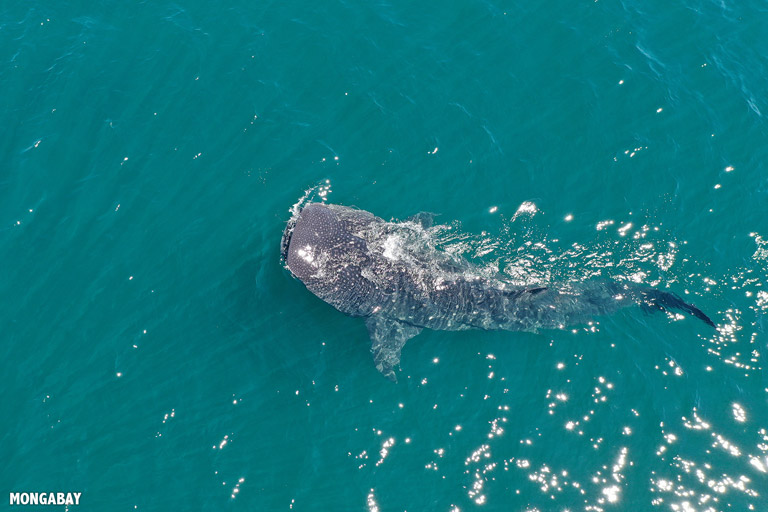
by DGR News Service | Jun 10, 2021 | Biodiversity & Habitat Destruction
- The Australian government has moved to create two new marine protected areas that cover an expanse of ocean twice the size of the Great Barrier Reef Marine Park.
- The two parks will be established around Christmas Island and the Cocos (Keeling) Islands in the Indian Ocean to the northwest of continental Australia.
- The new parks, which cover to 740,000 square kilometers (286,000 square miles) of ocean, raise the protected share of Australia’s oceans from 37% to 45%.
- The decision was immediately welcomed by conservation groups.
This article originally appeared on Mongabay.
Featured image: Whale shark feeding the ocean surface. Image by Rhett A. Butler for Mongabay.
The Australian government has moved to create two new marine protected areas that cover an expanse of ocean twice the size of the Great Barrier Reef Marine Park.
The two parks will be established around Christmas Island and the Cocos (Keeling) Islands in the Indian Ocean to the northwest of continental Australia. The new parks cover 740,000 square kilometers (286,000 square miles) of ocean.
The decision was immediately welcomed by conservation groups.
“Christmas and Cocos (Keeling) Islands are uniquely Australian and globally significant – there’s nowhere like them on Earth,” said Michelle Grady, Director of The Pew Charitable Trusts, in a statement. “Most famous for its annual red crab migration, Christmas Island was referred to as one of the 10 natural wonders of the world by David Attenborough himself. Its thriving rainforests, deserted beaches and fringing reef provide a haven for unique and rare seabirds, land crabs and marine life.”
“Christmas and the Cocos (Keeling) Islands are recognised as globally significant standout natural wonders,” added Darren Kindleysides, CEO of the Australian Marine Conservation Society, in a statement. “Oceans across the globe are in deep trouble from pollution, overfishing, habitat loss and the very real and immediate impacts of climate change. Establishing marine parks to provide a safe haven for our marine life is critical in helping stop our oceans reaching a tipping point.”
Christabel Mitchell, Director of the Save Our Marine Life Alliance, applauded the move but urged the Australian government to work “collaboratively” with local communities to “co-design” the protected areas.
“Healthy oceans and sustainable fishing are central to the Christmas and Cocos Islanders’ way of life, their culture and their livelihoods,” said Mitchell in a statement.
“Creating world-class marine parks for this region will provide crucial protection for a wealth of marine life, make a significant global contribution to the health of our oceans and support the local communities’ culture and aspirations,” said Mitchell. “We look forward to working with the government and the island communities to preserve this unique part of Australia, for our marine life and future generations.”
The new parks will bring the percentage of Australian waters under protection from 37% to 45%. Conservation groups around the world are pushing for the protection of 30% of global oceans and land mass by 2030.
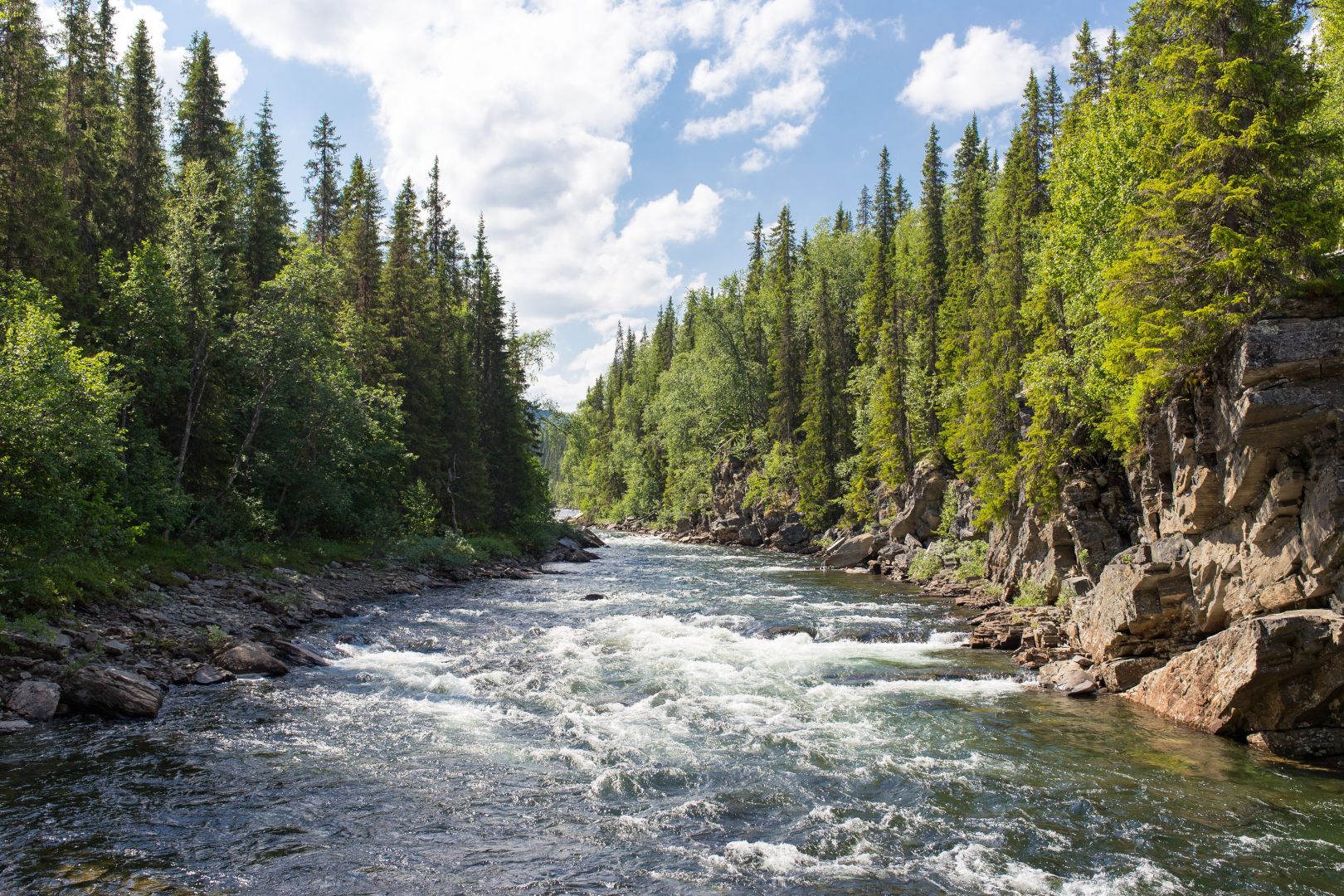
by DGR News Service | Jun 9, 2021 | Biodiversity & Habitat Destruction, Listening to the Land, Toxification
Biodiversity is plummeting, but restoring rivers could quickly reverse this disastrous trend.
This article was produced by Earth | Food | Life, a project of the Independent Media Institute.
By Alessandra Korap Munduruku, Darryl Knudsen and Irikefe V. Dafe
In October 2021, the Convention on Biological Diversity (CBD) will meet in China to adopt a new post-2020 global biodiversity framework to reverse biodiversity loss and its impacts on ecosystems, species and people. The conference is being held during a moment of great urgency: According to a report by the Intergovernmental Panel on Climate Change, we now have less than 10 years to halve our greenhouse gas emissions to stave off catastrophic climate change. At the same time, climate change is exacerbating the accelerating biodiversity crisis. Half of the planet’s species may face extinction by the end of this century.
And tragically, according to a UN report, “the world has failed to meet a single target to stem the destruction of wildlife and life-sustaining ecosystems in the last decade.”
It’s time to end that legacy of failure and seize the opportunities before us to correct the past mistakes, manage the present challenges and meet the future challenges that the environment is likely to face. But if we’re going to protect biodiversity and simultaneously tackle the climate crisis, we must protect rivers and freshwater ecosystems. And we must defend the rights of communities whose livelihoods depend on them, and who serve as their stewards and defenders. By doing so, we will improve food security for the hundreds of millions of people who rely on freshwater ecosystems for sustenance and livelihoods—and give the world’s estimated 140,000 freshwater species a fighting chance at survival.
Rivers Are Heroes of Biodiversity
At the upcoming CBD, countries are expected to reach an agreement to protect 30 percent of the world’s oceans and land by 2030. But which land is protected, as part of this agreement, matters immensely. We cannot protect just any swath of land and consider our work done. Member countries must prioritize protecting regions where biodiversity is highest, or where restoration will bring the greatest net benefits. Rivers, which support an extraordinary number of species, must be a priority zone for protection and restoration.
Rivers are unsung heroes of biodiversity: Though freshwater covers less than 1 percent of all the water on the planet’s surface, it provides habitats for an astonishing number of species. Rivers are vital for conserving and sustaining wetlands, which house or provide breeding grounds for around 40 percent of Earth’s species. That is a staggering amount of life in a very small geographic area—and those figures don’t account for all the adjacent forests and other ecosystems, as well as people’s livelihoods that rely on rivers.
Reversing the Decline of Rivers and Freshwater Ecosystems
Freshwater ecosystems have suffered from some of the most rapid declines in the last four decades. A global study conducted by the World Wildlife Fund, “Living Planet Report 2020,” states that populations of global freshwater species have declined by 84 percent, “equivalent to 4 percent per year since 1970.”
That is, by any measure, a catastrophe. Yet mainstream development models, water management policies and conservation and protected area policies continue to ignore the integrity of freshwater ecosystems and the livelihoods of communities that depend on them.
As a result of these misguided policies, fisheries that sustain millions of people are collapsing. Freshwater is increasingly becoming degraded, and riverbank farming is suffering as a result of this. Additionally, we’re seeing Indigenous peoples, who have long been careful and successful stewards of their lands and waters, face increasing threats to their autonomy and well-being. The loss of biodiversity, and the attendant degradation of precious freshwater, directly impacts food and water security and livelihoods.
But this catastrophe also suggests that by prioritizing river protection as part of that 30 percent goal, the global community could slow down and begin to reverse some of the most egregious losses of biodiversity. We have an incredible opportunity to swiftly reverse significant environmental degradation and support the rebound of myriad species while bolstering food security for millions of people. But to do that successfully, COP countries must prioritize rivers and river communities.
Here are a few things countries can do immediately to halt the destruction of biodiversity:
1. Immediately Halt Dam-Building in Protected Areas
Dams remain one of the great threats to a river’s health, and particularly to protected areas. More than 500 dams are currently being planned in protected areas around the globe, states Yale Environment 360, while referring to a study published in Conservation Letters. In one of the most egregious examples, Tanzania is moving ahead with plans to construct the Stiegler’s Gorge dam in the Selous Game Reserve—which has been a UNESCO World Heritage site since 1982 and an iconic refuge for wildlife. In terms of protecting biodiversity, canceling dams like these is low-hanging fruit if the idea of a “protected area” is to have any meaning at all.
2. Create Development ‘No-Go’ Zones on the World’s Most Biodiverse Rivers
Freshwater ecosystems face myriad threats from extractive industries like mining and petroleum as well as agribusiness and cattle ranching, overfishing, industrialization of waterways and urban industrial pollution. Investors, financiers, governments and CBD signatories must put an immediate halt to destructive development in biodiversity hotspots, legally protect the most biodiverse rivers from development, and decommission the planet’s most lethal dams.
3. Pass Strong Water Protection Policies
Most policymakers and decision-makers—and even some conservation organizations—don’t fully understand how freshwater ecosystems and the hydrological cycle function, and how intimately tied they are to the health of the terrestrial ecosystems they want to protect. Rivers and freshwater ecosystems urgently need robust protections, including policies that permanently protect freshwater and the rights of communities that depend on them. In some places, this may go as far as granting rivers the rights of personhood. A growing global Rights of Nature and Rights of Rivers movement is beginning to tackle just this.
4. Respect the Rights of Indigenous Peoples and Other Traditional Communities
Indigenous peoples protect “about 80 percent of the global biodiversity,” according to an article by National Geographic, even though they make up just 5 percent of the world’s population. These are the world’s frontline defenders of water and biodiversity; we owe them an enormous debt. More importantly, they deserve protection. It’s imperative governments respect Indigenous people’s territorial rights, as well as their right to self-determination and free, prior and informed consent regarding projects that affect their waters and livelihoods.
Many Indigenous communities like the Munduruku in the Amazon are fighting to defend their territories, rivers and culture. Threats to fishing and livelihoods from destructive dams, gold mining pollution and industrial facilities can be constant in the Tapajós River Basin in the Amazon and many other Indigenous territories.
5. Elevate Women Leaders
In many cultures, women are traditionally the stewards of freshwater, but they are excluded from the decision-making processes. In response, they have become leaders in movements to protect rivers and freshwater ecosystems around the globe. From the Teesta River in India to the Brazilian Amazon, women are leading a burgeoning river rights movement. A demand to include women’s voices in policy, governments and localities will ensure better decisions in governing shared waters.
The pursuit of perpetual unchecked economic growth with little regard for human rights or ecosystem health has led our planet to a state of crisis. Floods, wildfires, climate refugees and biodiversity collapse are no longer hallmarks of a distant future: They are here. In this new era, we must abandon rampant economic growth as a metric of success and instead prioritize equity and well-being.
Free-flowing rivers are a critical safety net that supports our existence. To reverse the biodiversity crisis, we must follow the lead of Indigenous groups, elevate women’s leadership, grant rights to rivers, radically reduce dam-building and address other key threats to freshwater.
What we agree to do over the next decade will determine our and the next generations’ fate. We are the natural world. Its destruction is our destruction. The power to halt this destruction lies in our hands; we only have to use it.
Alessandra Korap Munduruku is a Munduruku Indigenous woman leader from Indigenous Reserve Praia do Índio in the Brazilian Amazon. She is a member of Pariri, a local Munduruku association, as well as the Munduruku Wakoborûn Women’s Association. In 2020, Alessandra won the Robert F. Kennedy Human Rights Award for her work defending the culture, livelihoods and rights of Indigenous peoples in Brazil.
Darryl Knudsen is the executive director of International Rivers. He has 20 years’ experience channeling the power of civil society movements to create enduring, positive change toward social and environmental justice for the underrepresented. Darryl holds a master’s degree from Columbia University and a BA from Dartmouth College.
Irikefe V. Dafe has advocated for river protections in Nigeria and throughout Africa for three decades. Much of his work has focused on protecting the River Ethiope and the rights of communities who rely upon the river for food, water and their livelihoods. He is a lead organizer of the First National Dialogue on Rights of Nature in Nigeria. He is also the founder and CEO of River Ethiope Trust Foundation and an expert member of the UN Harmony with Nature Initiative.
![Tribal Members Aim to Stop Lithium Nevada Corporation From Digging Up Cultural Sites in Thacker Pass [Dispatches from Thacker Pass]](https://dgrnewsservice.org/wp-content/uploads/sites/18/2021/06/SageGrouse-980x667-1.jpg)










![The Rush For White Gold [Dispatches from Thacker Pass]](https://dgrnewsservice.org/wp-content/uploads/sites/18/2021/06/APrice-ThackerPasssky-1080x675-1.jpg)

